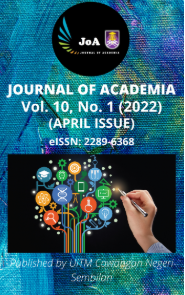CONTINUITY STUDY OF SPIDER DIVERSITY IN UNIVERSITI TEKNOLOGI MARA (UiTM) NEGERI SEMBILAN BRANCH, KUALA PILAH CAMPUS, NEGERI SEMBILAN, MALAYSIA
Keywords:
Diversity, Abundance, Lycosidae, Spider, ArachnidsAbstract
The data of the arachnids especially spider species in Malaysia are lacking due to the threats of the rainforest which is known to be the habitats of the species. Ninety-nine samples of spiders have been identified and documented in this study conducted in Universiti Teknologi MARA (UiTM) Negeri Sembilan Branch, Kuala Pilah Campus area with 11 families that consist of Araneidae, Corinnidae, Deinoppidae, Linyphiidae, Lycosidae, Oxyopidae, Pholcidae, Pisauridae, Salticidae, Sparassidae and Trachelidae. Sample collections were conducted at three different sites inside the campus using two different sampling techniques (active and passive). The highest abundance of spiders was in Site A (44%) but Lycosidae revealed to be the most abundant between the spider families. Site C had the uttermost diversity indices where Shannon-Wiener index, H’ = 1.55, evenness index, E = 0.71 and richness index, RI = 8.70 due to 13 spider species spotted in the site. This study is in continuity with preliminary surveys done at Forest Reserve in UiTM Negeri Sembilan Branch, Kuala Pilah Campus with much longer sampling time period and it revealed that diversity increased to 23 genera collected from the whole campus area in present study as compared to 13 genera from previous study. The continuation of arachnid study is beneficial to the ecosystem to conserve the spider’s species and habitats.
References
Castanheira, P., Pérez-González, A. and Baptista, R. L. C. (2016). Spider diversity (Arachnida: Araneae) in Atlantic Forest areas at Pedra Branca State Park, Rio de Janeiro, Brazil. Biodiversity Data Journal, 4, e7055. https://doi.org/10.3897/BDJ.4.e7055
Dasran, F. H. A. and Rahim, N. A. (2021). Preliminary Study of Spider Diversity in UiTM Negeri Sembilan Kuala Pilah Campus Forest Reserve. Journal of Academia, 9(1), 91-96.
Dzulhelmi, M.N. and Nasir, M. (2016). Distribution of Spiders in Malaysia with Special Emphasis of The Systematics and Ecology of The Orb-Web Spider (Araneae: Tetragnathidae) [Doctoral dissertation, University of Malaya]. University of Malaya Students Repository. http://studentsrepo.um.edu.my/id/eprint/7001
Gibb, T. J. and Oseto, C. Y. (2006). Anthropod Collection and Identification: Field and Laboratory Techniques. Elsevier Academic Press Publications, Oxford, UK: pp. 10-11.
Ifo, A. S., Moutsambote, J., Koubouana, F., Yoka, J., Ndzai, S. F., Bouetou-Kadilamio, L. N. O., Mampouya, H., Jourdain, C., Bocko, Y., Mantota, A. B., Mbembe, M., Mouanga-Sokath, D., Odende, R., Mondzali, L. R., Wenina, Y. E. M., Ouissika, B. C. and Joel, L. J. (2016). Tree Species Diversity, Richness, and Similarity in Intact and Degraded Forest in the Tropical Rainforest of the Congo Basin: Case of the Forest of Likouala in the Republic of Congo. International Journal of Forestry Research, 2016. https://doi.org/10.1155/2016/7593681
Labanon, K. K. O. and Nuñeza, O. M. (2020). Species Diversity of Salticid Spiders (Araneae: Salticidae) according to Elevation and Vegetation Type in Western Mindanao State University-Experimental Forest Area, Upper La Paz, Zamboanga City, Philippines. Bulletin of Environment, Pharmacology and Life Sciences, 9(5), 53-64.
Leaflet. (2020). Leaflet. Version 1.7.1. https://leafletjs.com/. [Access online 23 July 2021].
Mokthsim, N. (2018). Malaysia’s Case study of Forest Resources Management and Development. Journal of Governance and Development, 14(2), 45-58.
Myers, P. (2020). Arachnida: https://animaldiversity.org/accounts/. [Access online 13 December 2020].
Nasir, D. and Su, S. (2015). Common Malaysian Spider. Penerbit Universiti Putra Malaysia (UPM).
Potapov, A. M., Dupérré, N., Jochum, M., Dreczko, K., Klarner, B., Barnes, A. D., Krashevska, V., Rembold, K., Kreft, H., Brose, U., Widyastuti, R., Harms, D. and Scheu, S. (2019). Functional losses in ground spider communities due to habitat structure degradation under tropical land-use change. Ecological Society of America, 101(3), 1-14. https://doi.org/10.1002/ecy.2957
Štokmane, M. and Spungis, V. (2016). The influence of vegetation structure on spider species richness, diversity and community organization in the Apšuciems calcareous fen, Latvia. Animal Biodiversity and Conservation, 39.2, 221236. https://doi.org/10.32800/abc.2016.39.0221
Tietjen, W. L., Becker, S., Muenz, T. and Golladay, S. (2017). Observations on the Spider Fauna of Geographically Isolated Wetlands in Southwestern Georgia. Georgia Journal of Science, 75(2), 1-12.
Vasconcellos-Neto, J., Messas, Y. F., Souza, H. d. S., Villanueva-Bonila, G.A. and Romero, G. Q. (2017). Spider– Plant Interactions: An Ecological Approach. In Behaviour and ecology of spiders. Springer, Cham.: pp. 165-214.
Wong, T. S. (2019). Spiders of Borneo, Spiders of Sabah, Malaysia. https://pbase.com/wongtsushi/spider. [Access online 4 April 2021].
World Spider Catalog (2021). World Spider Catalog. Version 21.5. Natural History Museum Bern, https://wsc.nmbe.ch/. [Access online 23 July 2021].
Downloads
Published
Issue
Section
License
Copyright (c) 2022 Journal of Academia

This work is licensed under a Creative Commons Attribution-NonCommercial-NoDerivatives 4.0 International License.












